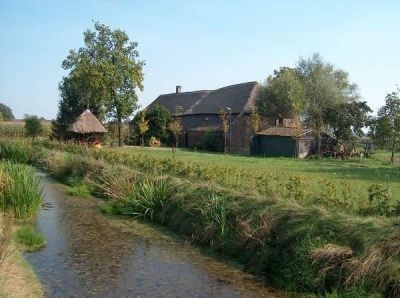Boerderij: Espse Hoeve, Bakel
Contact
Contents
- 1 Espse Hoeve
- 1.1 Archaeological research
- 1.2 The basis of the Esper farmstead
- 1.3 The construction and owners of the Esperhoeve
- 1.4 At the Peelrand fault
The Commandeurshoeve or Espse Hoeve is a moat from the 15th century, which was bought by the Gemert Commandery of the Teutonic Order in 1485 and remained part of the Gemert Castle property until the 20th century. Part of the moat has always remained. A project to restore moats around medieval farmsteads resulted in a vanished part of the moat being able to be excavated again in 2004. The remaining part of the moats has been given protected status as an archaeological monument.
Bakel, the Espse farmstead after restoring the moats Archaeological survey
A map of the farmstead exists…
Contents
- 1 Espse Hoeve
- 1.1 Archaeological research
- 1.2 The basis of the Esper farmstead
- 1.3 The construction and owners of the Esperhoeve
- 1.4 At the Peelrand fault
The Commandeurshoeve or Espse Hoeve is a moat from the 15th century, which was bought by the Gemert Commandery of the Teutonic Order in 1485 and remained part of the Gemert Castle property until the 20th century. Part of the moat has always remained. A project to restore moats around medieval farmsteads resulted in a vanished part of the moat being able to be excavated again in 2004. The remaining part of the moats has been given protected status as an archaeological monument.
Bakel, the Espse farmstead after restoring the moats Archaeological survey
A map of the farmstead exists from around 1788. That map shows a complex and unusual moat system. Archaeological research finally showed the moat pattern to consist of a rectangular area measuring 72 metres by 93 metres, surrounded by a moat averaging 2 metres deep and 7 metres wide. A circular moat with an ?128;island?128; joined this rectangular area. The circular moat averaged 8 metres wide and 2.50 metres deep. The island had a diameter of about 24 metres. On the ?128;island?128; a foundation of a brick building dating from about 1450 was found. The foundation stood exactly on the boundary of the former moat and the solid ground within it. Originally, a brick building will have been present. Brick buildings were rare at that time. Usually, only castles and churches were built in brick. In general, residential houses and farms at that time were made of wood and loam. The present dwelling house was apparently built of brick, with windows fitted with natural stone water frames and a slate roof. All in all, it may be concluded that a substantial dwelling house was present on the site for that time. The larger, contiguous rectangular site will have contained farm buildings of Aspen farmstead. The survey also revealed that a fire raged there in the late 16th century. Immediately afterwards, a new building will have been erected whose wooden trusses are still present in the current farmstead. All in all, it can be assumed that a moat system was constructed at Esperhoeve around 1450, within which a particularly rich house was built with separate outbuildings. Today's Esperhoeve farmstead is the remnant of this.
The basis of the Esper farmstead
In the oldest registers of landowners and land users, we find several people on Esp. These old registers show that the noble Van Bruheze family was the most important landowner on Esp. This family named itself after its most important property, the Bruheze estate, which later grew into the Bakel church village of Brouwhuis, now a residential area of Helmond. During the 14th century, land ownership on Esp fragmented among the various heirs of the van Bruheze family: Jorden van Bruheze, Jorden van Esp, Melis van den Broek (with the children of Gerrit van de Vondervoort as heirs) and Melis van de Laar van Gemert. All people belonging to the elite of Bakel and Gemert. The foundations of the Esperhoeve were laid from 1430 onwards. Jan van Amstel, son of Gerard van Amstel and married to Elisabeth Geerlings van Nuwelant, bought up a lot of property from the heirs of Gerrit van de Vondervoort and from the heirs of Jorden van Esp in the period between 1430 and 1450, thus reuniting the necessary land ownership on Esp. Jan van Amstel was an important large landowner in the region. Besides the properties on Esp, he also inherited property in Nuenen (the Te Coll property, the Papenvoort property and the Coll and Opwetten water mills) through his wife Elisabeth van Nuwelant. Members of the Van Amstel family are descendants of the well-known Utrecht/Holland Van Amstel family. The descendants of Gijsbrecht van Amstel, who was involved in the assassination of Floris V of Holland, left Utrecht and then ended up in north-eastern Brabant because of their kinship with the lords of Cuijk. Through the marriage of Sophia van Amstel, a granddaughter of Gijsbrecht, to the Bakel knight Hendrik van der Schaut, the Van Amstels ended up in the Bakel region. 9
The construction and owners of the Esperhoeve
Through the marriage of Maria, the daughter of Jan van Amstel

